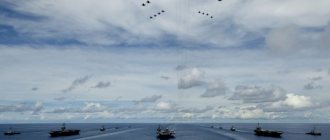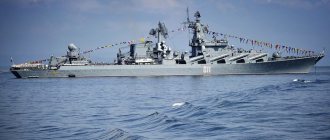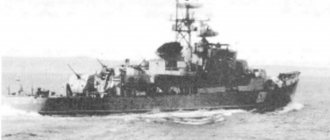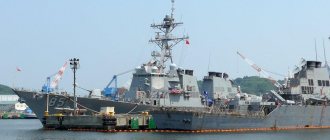Briefly about the comparison of the Russian and US fleets
There is no reason for scientific analysis here. The Russian Navy and the US Navy exist separately from each other, in different time periods. Just like the fleets of the First and Second World Wars.
Statistical methods don't work. With multiple quantitative gaps, it makes no sense to calculate the average age of the ship's personnel. As well as determining the percentage ratio of new and old ships. In reality, these % will be expressed by a different number of ships for each fleet. Too different to take this calculation seriously.
The phenomenon of "average temperature"
It is enough to exclude “outdated equipment” (ships built before 2001) from the calculations, and the unexpected will emerge. Over the first 15 years of the new century, American shipyards delivered 36 destroyers to the fleet (including the experimental Zamvolt and the burke-shaped Finn - not yet officially accepted into the Navy, but already launched and undergoing testing).
The General Dynamics Electric Boat shipyard showed no less serious results. During this period of time, 12 Virginia-class multi-purpose nuclear submarines and one Carter (Seawolf-class) special operations nuclear submarine were commissioned.
Among the major players are two nuclear-powered aircraft carriers, the Reagan and the George W. Bush. Another one (“Ford”), recognized as the largest warship in history, was launched in 2013, and this fall it will join the Navy.
PCU (pre-commission unit - an object at the stage of completion) John Finn. Another couple of months will pass and the PCU code will change to USS (United States Ship).
Among other aircraft-carrying ships, the following were built: - a helicopter carrier with the unexpected name “America” (an air wing of 30 helicopters, Harriers and F-35s). — two Wasp-class universal landing ships (“Iwo Jima” and “Makin Island”, each twice the size of the Mistral); — expeditionary mother ship-helicopter carrier “Puller” (78 thousand tons).
From the exotic - a maritime radar base for a missile defense system, designated SBX.
The next item is six high-speed coastal combat ships (LCS), duplicating the tasks of patrol ships, minesweepers and submarine hunters.
Other large units: 11 landing ships of the San Antonio type and two sea terminals for over-the-horizon landing of armored vehicles: Glenn and Montford Point.
In total, there is a “brigade” of seventy ships in the ocean zone with an average age of less than ten years. Here are all the statistics for you.
Excluding “obsolete” ships built in the 1980-90s. The oldest active ship remains the Nimitz (1975). However, age is not so terrible for aircraft carriers. Their main weapons are constantly evolving. Over the past 40 years, three generations of naval aviation have changed on the deck of the Nimitz (Phantom - F-14 - Super Hornet).
And again about the Russian threat
In reality, everything is somewhat different than on the beautiful trailer of the Russian fleet. The successes of domestic shipbuilders, as expected, turned out to be much more modest.
Baranets spoke about the fate of Ukrainian ships in the conflict with the Black Sea Fleet
The Black Sea Fleet has very powerful missile and air defense systems, and therefore, in combat conditions, the Russian military will not sit and wait for Ukrainian missiles to plop on the deck of ships. This opinion to the Federal News Agency by Komsomolskaya Pravda military observer Viktor Baranets .
Thus, FAN's interlocutor commented on the publication of the American magazine Forbes, whose journalists spoke about the possible use of new tactics of Ukraine in the Black Sea in order to set a trap for the Russian Navy.
The authors of the material explained that the forces of the Russian Black Sea Fleet (BSF) significantly exceed the capabilities of Ukrainian ships. Thus, Russia has a cruiser, a destroyer, seven submarines, five frigates and 20 patrol boats in the Black Sea. At the same time, in 2020, the military-industrial complex of Ukraine was able to build only seven ships. In addition, Kyiv received several patrol ships of the American Coast Guard.
“No one is seriously considering the possibility of a real military clash between the Ukrainian Navy and the Russian fleet. Kyiv’s ships will be assigned other tasks,” the journalists explained.
In an armed conflict, the Ukrainian military will rely on batteries of anti-ship cruise missiles, and patrol boats will act as mobile observation posts and nodes of the maritime situation warning system. Forbes noted that Ukraine already has missiles. We are talking about the R-360 anti-ship missile of the Neptune complex. According to journalists, these Ukrainian weapons can hit surface targets at a distance of 280 kilometers. Thus, Ukraine can not only pose a threat to the Russian fleet in half of the Black Sea, but also turn the region into an “inevitable” trap for the Russian Navy.
Assessing the Forbes article, military expert Viktor Baranets said that such “childish nonsense was typical only for specialists from Ukraine,” but now also to the United States. He noted that Ukrainians are now very proud of the Neptune missile system.
“Forbes magazine specialists, when they argue that these missiles can pose a real threat to the Black Sea Fleet, forget only one thing: “Will the Russian military from the Black Sea Fleet with its air defense systems located on ships and along the Black Sea coast in Crimea sit idly by?” and wait until the Neptunes plop onto the decks of our cruiser?” All this is childish nonsense. In this case, the situation is viewed only in such a way that Russia does not have missile defense systems at all. But this is not how Forbes can think, but in some Kiev madhouse.
We all understand perfectly well that the Black Sea Fleet has very serious air and missile defense. Perhaps almost no region of Russia (with the exception of the central one) has such a powerful anti-aircraft umbrella that Crimea has. It seems to me that such fortune telling on fake cards cannot cause serious analytical and expert reflection among serious specialists,” Baranets explained in an interview with FAN.
FAN's interlocutor laughs when journalists talk about the role of Ukrainian boats in the conflict with Russia, which the United States plans to transfer to Kyiv.
“The Americans were going to send them for scrap, and then they lightly touched them up with a little paint and handed them over to the happy Ukrainians. This is something new in naval tactics, when boats will serve as mobile observation posts. If there is a real combat situation, then these points will be blown away from the surface of the sea like flies from a dung pit. Russia has enough means to deal with these boats,” the military expert assured.
In addition, Baranets drew attention to the imperfection of the Neptune missile systems due to their lack of a target guidance system.
“There will be people sitting in the boat who will see something on the radar, but there is no guidance system for the Neptune. These missile systems are good old Soviet weapons, slightly spoiled by Dnepropetrovsk craftsmen. This is a missile well known for its tactical and technical characteristics. In the Russian army, this weapon has been modernized for a long time, and its capabilities are not comparable to the “Neptune” that the Ukrainians so happily talk about,” the military expert added.
Earlier it was reported that Ukraine intends to deploy three divisions of anti-ship systems with Neptune cruise missiles in the Black and Azov Seas. According to the commander of the Ukrainian Navy, Alexei Neizhpapa , Russia is the main enemy, and therefore Kiev needs to fight such a neighbor with the help of technology and the quality of military training.
US Navy: composition, financing and problems
According to US President Donald Trump, the state of the Navy has dropped to the level of the First World War
US President Donald Trump, during his election campaign, pointed out serious problems associated with the financing and combat effectiveness of the US armed forces, and on Monday said that the country's naval forces are “almost at the same low level as in the First World War " About the state and composition of the American Navy, as well as whether the statement of the 45th President of the United States is true - in the TASS material
US Navy: Basic Facts
- $619 billion
US military budget for fiscal year 2020
- $165 billion
budget requested by the United States Navy for fiscal year 2020
- 323,197 people
on active military service in the US Navy
- 3700
aircraft in service with the US Navy
- 274
ship in US Navy service
- 70
submarines in service with the US Navy
- 10
aircraft carriers in service with the US Navy
Budget in comparison
To get a rough idea of the amount of funds the Navy has requested for fiscal year 2020, it is enough to compare this amount ($165 billion) with the total military budget of other countries. Thus, in 2020, the total military budget of Russia, Great Britain and Germany amounted to $162 billion. However, even such a colossal amount, which two years ago was enough to provide the armed forces (including the army, navy, and aviation) of the three world powers, for the military US naval forces are not enough.
Thus, on Tuesday, the Pentagon approached the US Senate with a plan to increase the military budget by $30 billion, of which $11 billion would be for the needs of the Navy. According to the naval command, if additional funds are not allocated, the fleet's combat readiness will suffer greatly.
Fleet size and Trump's promises
On Monday, Donald Trump made a statement at MacDill Air Force Base in Florida in which, in addition to comparing the state of the US Navy before 1914 with today, he promised that “not a single taxpayer dollar will be wasted.” There are currently 274 warships in service with the US Navy. For comparison: in August 1945, this figure was many times higher - 6,768 ships.
In his election campaign, the 45th president set out to restore the country's armed forces and increase defense spending. And part of his plan, announced in September 2016, was to bring the total number of warships to 350.
The country's naval forces themselves came up with a similar initiative in December 2020: within 30 years, according to the Navy, it is necessary to increase the number of ships to 355. And this implies additional annual costs of $25 billion for the construction of new ships.
Exactly a week after his inauguration, Trump signed an executive order on a significant reorganization of the country's armed forces, partially fulfilling his promises. According to the document, within 60 days, the new Secretary of Defense James Mattis must present to the President a plan to improve overall combat readiness by the 2020 fiscal year. And it is quite expected that an increase in the size of the fleet and funding for the Navy will be mentioned in this regard.
In general, comparisons of the US Navy with those of the early 20th century are very popular among Republican politicians, from current Secretary of Housing and Urban Development Ben Carson to former presidential candidate Mitt Romney. Democrats take a different point of view and believe that quantity does not mean quality, and the combat capabilities of modern ships surpass not only the capabilities of ships of the 1910s, which is quite natural, but also modern analogues in service with other countries, such as Russia and China.
Obama's problematic legacy
As the American weekly Defense News reported, the Navy currently does not have enough funds even to repair existing ships, and the backlog of deferred repairs is constantly growing. Of all the multirole ship-based fighters of the Navy, only every third aircraft can take to the skies. The remaining two thirds cannot due to technical reasons (they are either undergoing repairs or are awaiting delivery of spare parts). Trump “inherited” this systemic problem from the former president.
During the presidency of Barack Obama, military spending decreased significantly: in 2010, the budget was $721 billion, and by 2013 it had fallen to $610 billion. The trend towards a gradual increase in defense spending appeared only in 2020. At the same time, Republican President George W. Bush managed to double defense spending over the eight years of his presidency - from $335 billion in 2001 to $698 billion in 2009.
Alexander Mosesov






